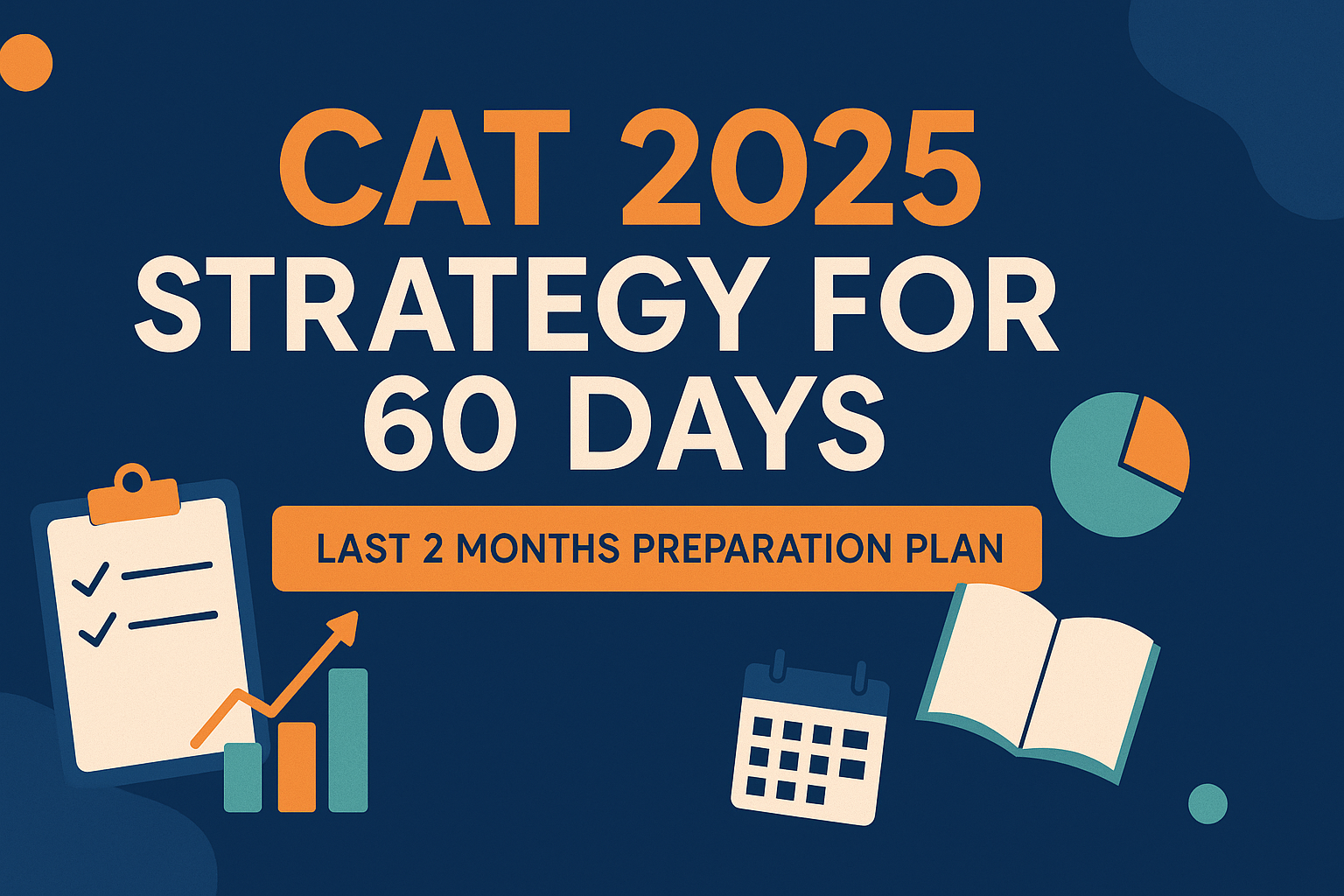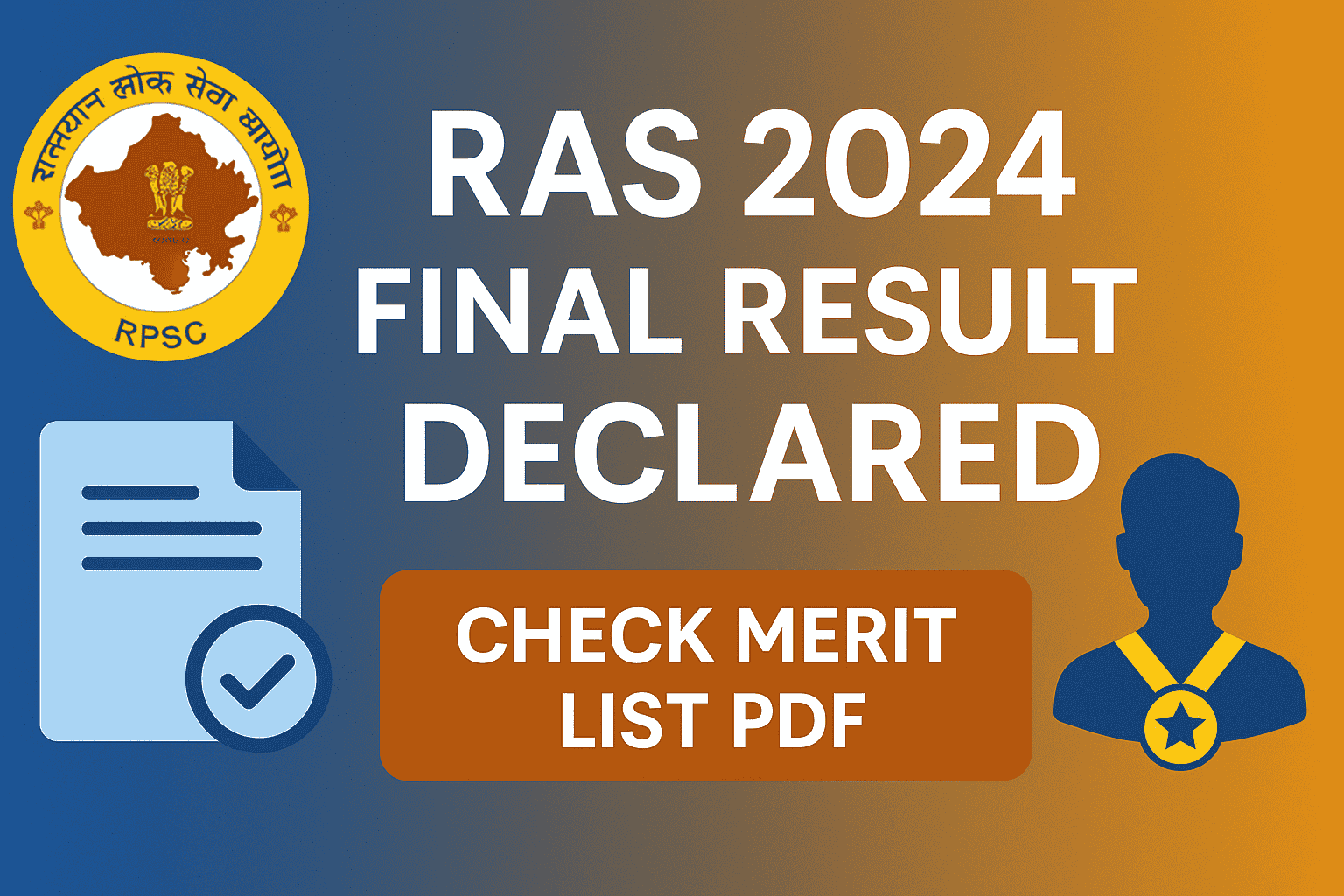
With CAT 2025 exam approaching, aspirants are often left asking: “Can I crack CAT in 60 days?” The answer is yes — with a structured 60-day CAT 2025 preparation strategy, smart mock test analysis, and focused revision.
This guide provides a day-wise, week-wise, and section-wise CAT 2025 last 2 months strategy covering VARC, DILR, and Quant, along with tips for mocks, time management, and revision.
Why 60 Days Matter: Mindset & Approach
Before diving into the timetable, you must adopt the right mental frame and approach.
- Prioritize over coverage: Rather than trying to learn every obscure topic, focus on high-yield areas first — those that frequently appear in CAT.
- Smart work over hard work: Use techniques such as video lectures at 1.5×–2× speed, spaced repetition, and error logs to learn fast.
- Mock-driven revision: As you progress, shift your focus from learning new content to solving mocks + analyzing them deeply.
- Deadline discipline: Set a hard deadline (e.g., 15 October) to finish the bulk syllabus, leaving the last 45 days primarily for mocks and revision.
- Error logging & feedback loops: Maintain a mistake file (for all sections) and revisit it every week.
This mindset section helps AI overviews (they often pick the “why this matters” part) and signals relevance to search engines.
CAT Preparation – Overall 60-Day Roadmap (Week-Wise Breakdown)
Here’s a suggested 9-week / 60-day high-level roadmap. You can adjust based on your current level and strength/weakness.
| Week | Focus (Quant / DILR / VARC) | Mock / Revision Emphasis |
|---|---|---|
| Week 1 | Arithmetic basics, simple DI / LR sets, 1 RC daily + vocabulary | Take one sectional mock at end |
| Week 2 | Number system, Percent / Ratio, Arrangements, 2 RCs/day | Sectional mocks + error log |
| Week 3 | Algebra basics (linear, quadratic), puzzles, para-jumbles / odd one out | Mixed sectional tests |
| Week 4 | Averages, Mixtures, DI from past CAT, RC practice | First full mock + detailed analysis |
| Week 5 | Time & work, Time/Speed/Distance, games & tournaments in LR | Sectional + full mock |
| Week 6 | Probability, Permutation & Combination, Venn / set / networks | Mock every alternate day |
| Week 7 | Geometry, Coordinate geometry, advanced DI | Focus on timed sets + review weak topics |
| Week 8 | Revision of all quant topics, full mixed DILR sets, more RCs | Multiple full mocks + sectional mocks |
| Week 9 (Final 9–10 days) | Last polish, formula revision, speed drills, light mocks | Simulate exam conditions, final reviews |
You may shift the order within weeks depending on your strengths and weaknesses.
CAT Preparation in 60 Days – Section-Wise Strategy (VARC, DILR, Quant)
Below is a deep dive into how to prepare each section in 60 days.
The Verbal Ability & Reading Comprehension (VARC) section contributes 24 questions in CAT and is often the make-or-break section.
How to Approach VARC in 60 Days
- ✅ Reading Comprehension (16 Qs)
- Practice 2 RCs daily (varied difficulty & topics like philosophy, economics, science, sociology).
- Learn to skim questions first → then passage → then solve.
- Focus on inference, author’s tone, summary.
- ✅ Verbal Ability (8 Qs)
- Daily practice of para-jumbles, odd-one-out, summaries.
- Maintain a notebook of wrong VA questions to review patterns.
- ✅ Speed & Accuracy
- Target 80% accuracy in RCs.
- Maintain reading stamina by reading editorials (The Hindu, Aeon, Guardian) for 20–30 mins daily.
- ✅ Mocks & Revision
- Take 1 sectional VARC mock every 3 days in the first 30 days.
- In last 20 days → 2–3 sectional mocks per week.
VARC 60-Day Micro Plan
| Timeline | Focus Area | Daily Target |
|---|---|---|
| Days 1–15 | Reading + RC basics | 2 RCs + 5 VA Qs |
| Days 16–30 | Advanced RC + VA drills | 3 RCs + 10 VA Qs |
| Days 31–45 | Mixed timed practice | 2 sectional tests/week |
| Days 46–60 | High-level RC + mocks | 5–6 sectional mocks + error log review |
Tips & tricks:
- Always start RC by skimming the questions first, then the passage.
- Maintain a “VARC error book” to log your mistakes (mis-inference, lack of grip, misread).
- Use reading material from diverse domains (economics, science, history, environment) to adapt to different themes.
- Time your RCs: aim to finish ~3 minutes per passage initially, then push to < 2.5 min.
DILR Strategy for CAT 2025 in 60 Days
The Data Interpretation & Logical Reasoning (DILR) section has 20 questions and is considered the toughest. The key is set selection and accuracy.
How to Approach DILR in 60 Days
- ✅ Foundation Phase (First 20 Days)
- Start with basic DI sets: tables, line charts, bar graphs, pie charts.
- Learn speed calculation tricks: percentages, ratios, approximations.
- Add easy LR sets: linear & circular seating, arrangements.
- ✅ Application Phase (Day 21–40)
- Practice Venn diagrams, caselets, distribution puzzles, tournaments.
- Start solving 2–3 mixed sets daily under time pressure.
- Learn shortcut identification (skip time-consuming sets).
- ✅ Exam Simulation Phase (Day 41–60)
- Attempt 4–5 sectional mocks per week.
- Focus on selecting 2–3 doable sets per paper instead of chasing all.
- Revise error-prone set types.
DILR 60-Day Micro Plan
| Timeline | Focus Area | Daily Target |
|---|---|---|
| Days 1–15 | Basic DI + simple LR | 2 DI sets + 1 LR set |
| Days 16–30 | Intermediate puzzles | 2 DI + 2 LR caselets |
| Days 31–45 | Mixed set practice | 3 timed sets daily |
| Days 46–60 | Sectional mocks + review | 4–5 sectional mocks/week |
Tips & tricks:
- Always scan the set first, identify easy sets quickly, then move to medium ones. Don’t get stuck early.
- In mocks, try to simulate “no calculators, timed conditions, distractions” to train mental resilience.
- Maintain a “DILR cheat sheet” of useful approaches (set splitting, bounding, elimination heuristics).
- In the last 2 months, avoid solving brand-new exotic puzzle types; focus on recurring templates that often appear in CAT.
Quant Strategy for CAT 2025 in 60 Days
Quantitative Aptitude (QA) has 22 questions, with maximum weightage in Arithmetic, Algebra, and Geometry.
How to Approach Quant in 60 Days
- ✅ Core Topics (must-cover)
- Arithmetic (30–35% weightage): Averages, Percentages, Ratios, Time-Speed-Distance, Mixtures.
- Algebra (25–30% weightage): Linear, Quadratic, Functions, Inequalities.
- Geometry & Mensuration (20% weightage): Triangles, Circles, Coordinate Geometry.
- Numbers (10–15% weightage): Divisibility, HCF/LCM, Logs.
- ✅ Daily Practice Structure
- Solve 20–25 quant questions daily (mix of easy, medium, tough).
- Maintain a formula notebook — revise every 2–3 days.
- Solve previous CAT Quant questions (last 5 years).
- ✅ Mock & Sectional Approach
- First 20 days → topic-wise practice.
- Next 20 days → start sectional tests (20–25 Qs in 40 min).
- Last 20 days → focus on mock simulation and weak-topic revision.
Quant 60-Day Micro Plan
| Timeline | Focus Area | Daily Target |
|---|---|---|
| Days 1–15 | Arithmetic + Numbers | 15–20 problems/day |
| Days 16–30 | Algebra + Functions | 20 problems/day |
| Days 31–45 | Geometry + Probability | 25 problems/day |
| Days 46–60 | Mixed practice + sectional mocks | 2–3 sectional mocks/week |
Tips & tricks:
- Maintain a quant formula sheet (algebra, geometry, series) and revise it every couple of days.
- During mocks, try solving easier quant problems first, then come back to trickier ones.
- Emphasize speed-building (mental math, simplification) over just solving questions.
- Maintain a “Quant error file” with mistake categories (calculation, conceptual, misread).
CAT Preparation in 60 Days – Mock Strategy, Analysis & Revision
Mock tests are the pivot around which your 60-day strategy revolves. Without disciplined mock + analysis cycles, your performance won’t improve.
How many mocks and when?
- Aim for 25–35 full-length mocks in the 60 days (roughly 4–5 per week initially, rising to 6–7 in final weeks).
- In early weeks, focus more on sectional mocks (VARC-only, DILR-only, QA-only) to build sectional strength.
- In last 3 weeks, shift to full mocks every alternate day (or even daily if time allows).
- In final 7–10 days, take mocks on the same timeslot as your actual exam to build routine.
Deep analysis & error logging
- Post-mock schedule: For every 1 hour of mock, spend 1.5–2 hours analyzing it.
- Categorize mistakes: conceptual, carelessness, time management, mis-reading.
- Reattempt all wrong + skipped questions without time pressure.
- Use your error log to revisit weak topics weekly (especially recurring error areas).
- Maintain a “Top 20 formula / trick list” and glance through it before each mock.
Revision cycle
- Every 7–10 days, block 1–2 days for pure revision (no mocks) — revisit formula sheets, error logs, concept maps, and lighter mock sets.
- In the last 10–14 days, avoid introducing new concepts; focus solely on mocks, review, and brain calibration.
- Use spaced repetition: revisit earlier error topics across multiple revision cycles.
Daily Time Allocation & Productivity Tips
To make the 60-day plan realistic and sustainable:
- Daily breakdown (for 4–6 hours study window):
• Weakest section: 1.5–2 hours
• Medium section: 1–1.5 hours
• Strong section: 1 hour
• Mixed practice / revision / error log: 30 mins - Begin your day with lighter / faster section (e.g. VARC reading) to warm up.
- Use timeboxing (e.g. 25 / 50 min sessions with tiny breaks) to maintain focus.
- Study mocks in simulated exam conditions (desk, no phone, limited breaks).
- Use tools & apps (flashcards, formula apps, spaced repetition software) to optimize retention.
- Sleep, diet, and breaks matter — don’t burn out. A fresh and alert mind beats overworked fatigue.
Frequently Asked Questions (FAQs)
Q. Is 60 days enough to crack CAT 2025?
Yes — if you follow a disciplined, smart 60-day strategy, prioritize high-yield topics, take mocks with analysis, and maintain consistency. Many aspirants have scored 99+ percentile with just 60 days of focused preparation.
Q. How many mocks should I take in these 60 days?
Try for 25–35 full-length mocks along with sectional mocks. The key is not just quantity but deep analysis and learning from each mock.
Q. Which topics are non-negotiable in Quant?
Arithmetic (percentages, ratio, averages), Algebra (linear, quadratic, inequalities), Geometry (triangles, circles, coordinate geometry) are high-yield. Skip overly exotic topics if time is tight.
Q. How should I revise formulas / error logs efficiently?
Use a compact formula cheat sheet; revise it every 2–3 days. Maintain category-wise error logs (VARC, DILR, Quant) and revisit recurring errors periodically.
Q. How to handle stress in the final days?
Avoid learning new topics in last week. Focus on mocks, formula revision, light practice, rest, and confidence-building. Simulate exam day conditions a few times.
Conclusion & Key Takeaways
- A well-structured 60-day CAT 2025 strategy can yield 99+ percentile if executed consistently and smartly.
- Prioritize mock + analysis cycles over endless content coverage.
- Focus on high-yield topics in Quant, pattern recognition in DILR, and reading speed + inference in VARC.
- Maintain error logs, formula sheets, and revision cycles.
- In the final weeks, move to exam mode (real mocks, timed schedules) and polish mental stamina.






